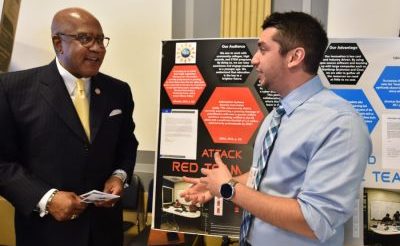Community College Students to Showcase STEM Innovation Skills in National Competition

Community college students have the opportunity to present their science, technology, engineering and mathematics (STEM) projects and ideas through a national innovation competition starting in March.
The contest, called the Community College Innovation Challenge (CCIC), is an initiative of the National Science Foundation (NSF), in partnership with the American Association of Community Colleges (AACC). It started in 2015 and was held until 2018. It wasn’t held in 2019 but has been relaunched this year.
“The CCIC is made possible through a strong and ongoing partnership between the National Science Foundation and the American Association of Community Colleges to advance the nation’s community colleges and community college students in STEM innovation and impact,” said Ellen Hause, program director for academic and student affairs at AACC.
Under the program, teams of two to four students collaborate with a college faculty member or administrator to compete for a cash prize through a two-phase entrepreneurship contest in the Washington D.C. area. This year, AACC predicts that around 50 to 60 teams will enter the competition.
“This program is a tremendous opportunity for community college student teams to advance STEM solutions to real-world problems, learn strategic communication and entrepreneurial skills from industry professionals and have the opportunity to be highlighted in a national forum,” said Hause.
In past years, teams have developed solutions to reduce environmental and noise pollution, found automated ways to grow plants and crops and focused on areas such as mobile technology, urban greenhouses and thermal energy.
In the first phase of the competition, teams apply online by writing a 500-word essay on their project idea, answering questions and submitting a 90-second video. For this year’s competition, applications must be submitted by March 31.
To be eligible for the competition, each student must be working toward a two-year degree in the U.S. or its territories, be in good standing and be 18 years old. Students and mentors are also required to be U.S. citizens or permanent residents.
Each submission is evaluated by a panel comprising NSF and AACC members, and community college experts. And submissions are judged based on three categories: innovation and impact, feasibility and clarity of communication.
According to Dr. Virginia Celeste Carter, program director at NSF, the first phase “cultivates critical thinking, research skills, problem-solving skills and teamwork skills.”
Up to 10 of the highest-scoring teams are selected for the second round of the competition and teams are notified of the results by late April. All student and faculty finalists are awarded a $500 cash prize.
Finalists then attend an Innovation Boot Camp in June which consists of a poster session and reception on Capitol Hill as well as a formal team presentation. Travel costs to the boot camp are fully financed by NSF.
Teams must develop a three-to-five-minute presentation or live demonstration of their idea and then participate in a five-minute question and answer session with the judges.
Photo by Matthew Dembicki, AACC
A good poster demonstrates “social need, exhibits enthusiasm and convey(s) the innovation’s value and significance,” according to CCIC’s website.
Dr. Martha M. Parham, senior vice president of public relations at AACC, said this event will give students the chance to leave their school “bubble” and interact with new colleagues and peers.
“They have to learn how to present themselves, it’s not enough to have a great idea,” said Parham. “They also have to figure out how to make sure other people can buy into that idea. So, that kind of real-world experience and training is really valuable.”
At the end of the competition, the winning team receives $1,500 and the second-place team gets $1,200.
“We hope students come away with the understanding of their significant value and impact as student innovators and gain the confidence and skills needed to advance their ideas, research and innovations beyond the classroom, laboratory or workshop and into the world where they can benefit society,” said Hause.
NSF’s Carter said she found that in past years students greatly benefited from the competition.
“I have seen students come together as a team and overcome anxiety about public speaking, increase their self-confidence in their abilities and skills and see STEM concepts and disciplines as more than just something they need to do in an academic program,” she said.
Past students have also used their CCIC experience to gain admission to advanced degree programs, pursue new career fields and venture into entrepreneurship by starting their own companies, according to Hause.
“Students have reported the CCIC experience to be life-changing,” she added. “I have personally seen students gain the self-confidence and skill sets that benefit them in their future studies and career endeavors.”
Sarah Wood can be reached at [email protected].
